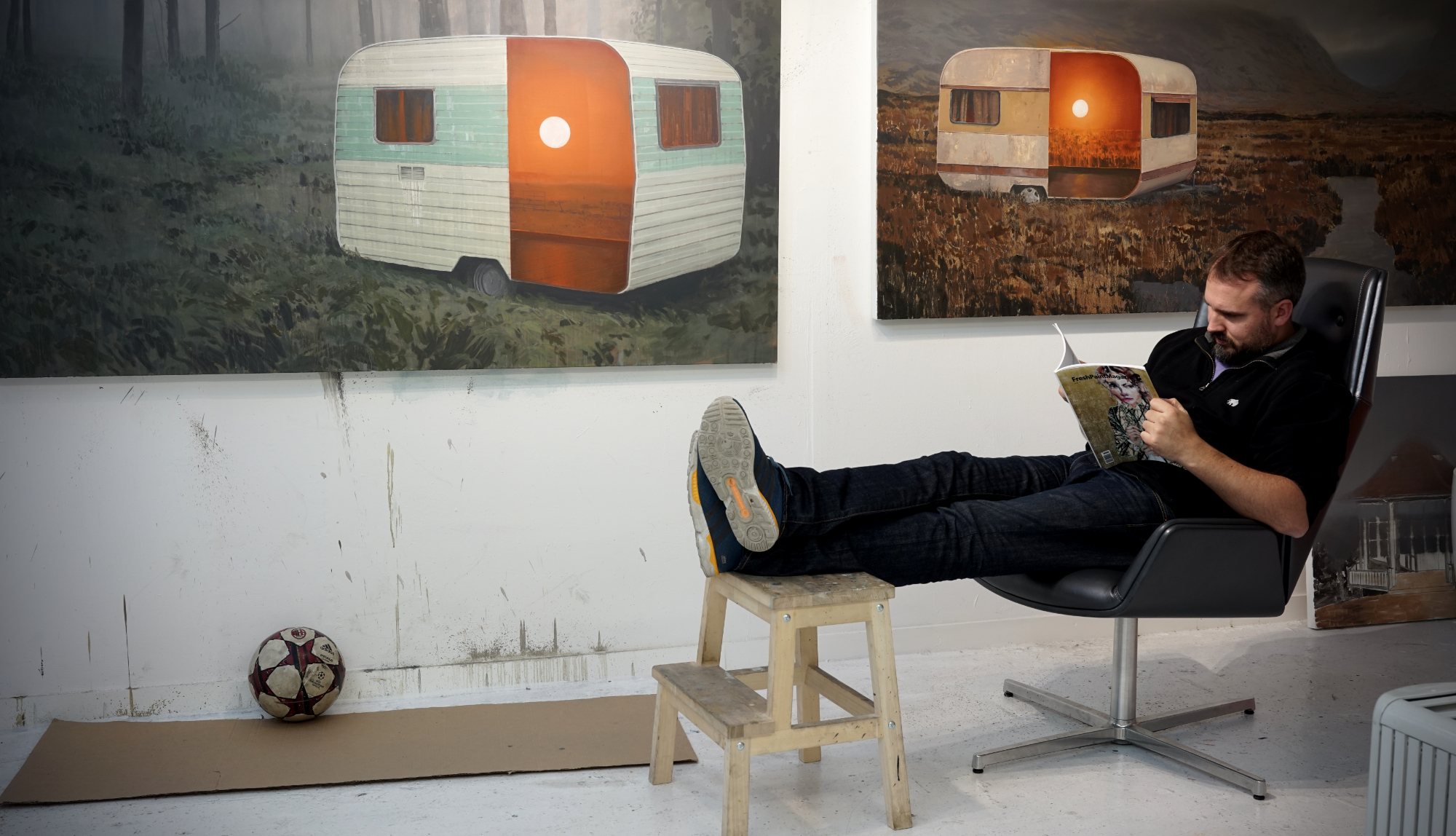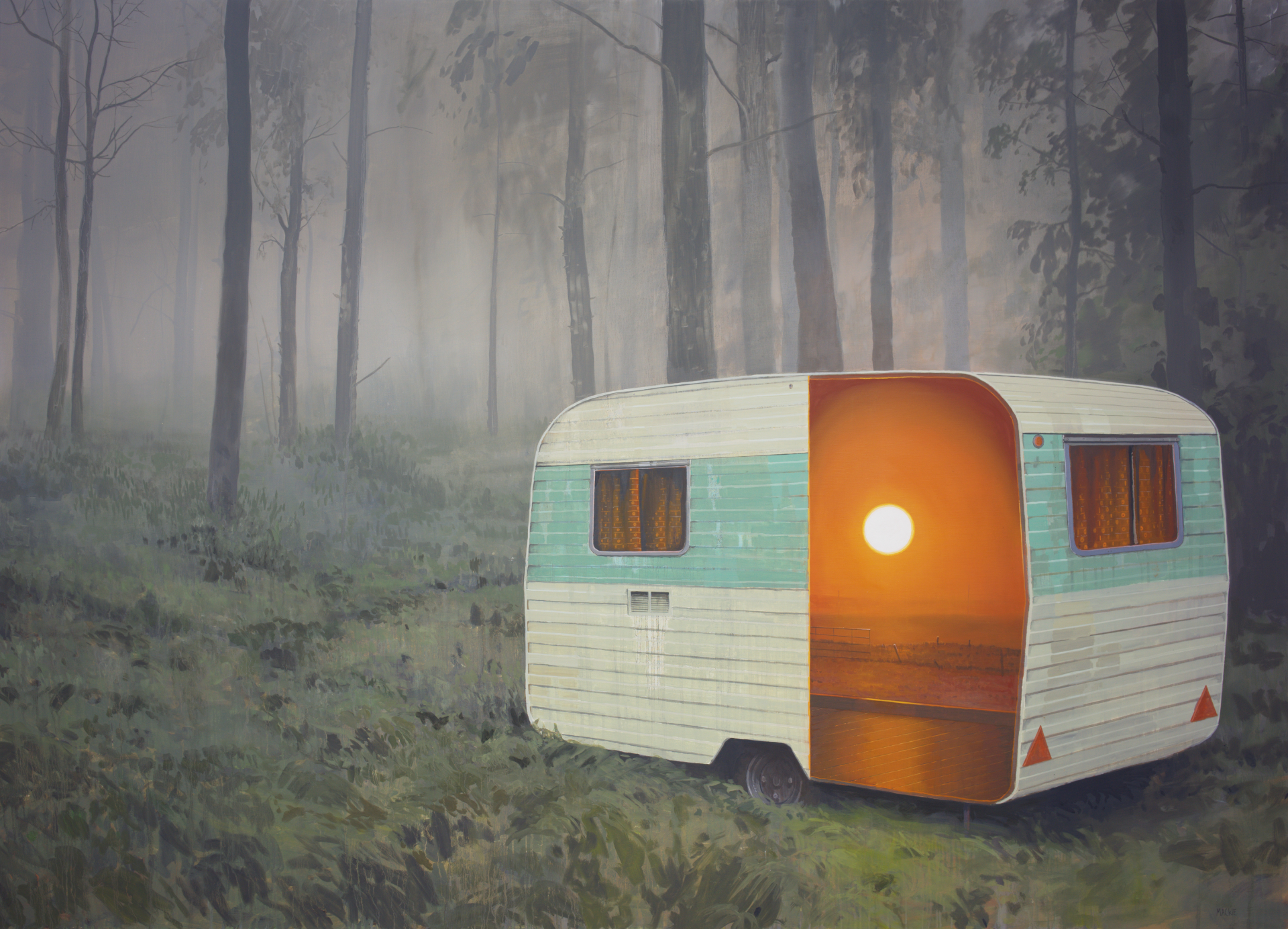Copyright @ Andrew McIntosh

Where We Belong
December 2016 with Bo Lee Gallery at Pulse Miami
Selected Works

Rose & Thorns
oil on linen
250x180cm

The Raven
oil on linen
180x120cm

Three Sisters
oil on linen
140x100cm

Merlin
oil on linen
150x110cm

The Black Horse
oil on linen
180x130cm
WHERE WE BELONG - Matt H Price
The Scottish Highlands offer a suitably atmospheric, picturesque and evocative location for Mackie’s latest body of work, Where We Belong (2016). It is a place that the artist knows well, having grown up with views of hills and fields on every side of his family home in the Cairngorms. It is a landscape that he himself views not through romantic eyes, however, but rather in terms of more practical concerns – how long will it take to walk through to the other side of the valley before nightfall; how marshy are the moorlands and must they be circumnavigated or can they be traversed on foot; how perilous is the icy snow that covers the scree that spills down the hillsides. It is a treacherous place for the ill-prepared rambler or dewy-eyed sightseer, and even presents dangers for the locals if they let down their guard for a moment against the harsh daily challenges of living in such a place.
In Merlin (2016), the artist depicts a burnt-out, dilapidated small stone dwelling – it looks like it might be very old, slashed and burned by Vikings or a rival clan, perhaps, but it turns out it is not so ancient as it might appear. Its owner had thrown some ashes from his hearth out of the back door before going out for the evening, only to return home to discover his home burnt to the ground. With few options open to him, he bought a caravan which he parked alongside the back wall of the house, and moved into that. Mackie captures the heart-breaking scene at dusk on a foggy evening, the low-lying dark grey mist hanging over the cottage as if clouds of smoke from the fire. Part of the caravan has been cut away, exposing the interior. We don’t see the owner inside, making do in his potentially long-term temporary accommodation; instead we see something quite unexpected – a glorious golden sunset over a very different kind of landscape: one that looks decidedly reminiscent of the American Midwest. The warm orange glow, which, from a distance or on first glance might appear like a lamp or bright candle, implies a warmth and cosiness that is otherwise entirely absent in the scene. The indoor sunset, like a 70s photographic mural, is incongruous to say the least, verging on the surreal or metaphysical. Mackie has filled a spatial void with an open-ended metaphor, a signifier that is open to our imaginations, to our interpretation. Here, in the pitiable shadow of the charred shell of the man’s home, there is something unusual, something special taking place, the precise nature of which we can’t quite guess – an element of mystery and magic that is captured in the work’s title.
The caravan is a motif that spans, and indeed defines, the whole body of work, appearing in a variety of beautiful, sometimes dramatic, sometimes haunting Highland environments, and always surrounded by a thick grey mist. These aren’t the caravans of your average holidaymaker, however, as they all seem to have seen better days. Undoubtedly some caravan enthusiasts would be able to discern which models they might be, from which manufacturer, which country and year, but to the layman they look like they probably date between the 1960s and 1980s, and are a far cry from contemporary state-of-the-art caravan design. Each conveys a sense of nostalgia through their modernist retro shapes and colours – colours which interact surprisingly harmoniously with the eerily subdued palettes of the landscapes surrounding them – though to be holidaymaking in any of these today would be glamping without the glamour. They are all of the kind that is towed by another vehicle, and all look like they might have been abandoned – though perhaps only recently so, as while they are battered and worn, they are not overgrown in the way that nature has a tendency to do to man-made things when left to its own devices.
The caravans are so picturesquely positioned that one might go so far as to suggest that they have been deliberately left in these places, as if with a clear intention in mind. It would not be inconceivable that such caravans could be used as ad-hoc shelters by grouse or pheasant hunters, birdwatchers, hillwalkers or other special-interest groups who spend long periods of time in the landscape, but this just doesn’t quite ring true here. There is something quietly disturbing about the presence of these caravans, poised somewhere between melancholy and malfeasance. The series of paintings is highly cinematic or televisual in nature, as if carefully contrived scenes or sets, and the viewer might struggle to resist looking to impose filmic narratives on each work – narratives that might involve thriller-style wrong-doing such as abduction or murder, but could equally take us into the realms of horror, science-fiction and the paranormal. Mackie’s accomplished painterly realism only serves to enhance this blurring of the real world and fiction.
And of course, we must face the elephant in the room here – just as in Merlin, the caravans in each of the other paintings in the series also have half of their sides cut away to reveal otherworldly scenes within them. Each unexpected scene is a sunset over a landscape, the sun glowing in the sky from bright white to hazy yellow, golden orange to umber-tinged red, evocative of great Romantic landscape paintings by the likes of Turner, Claude, Lieste or, more pertinently, Hudson River School painters such as Bierstadt, Cole or Church. The scenes are depicted as if flat on the interior back wall of the caravan, but the most curious thing – and the painterly device that really takes these works towards the metaphysical – is that the suns inside the caravans are casting light onto the floors of the caravans and even, sometimes, onto the ground outside. These interior scenes, while they look like painted landscapes, cannot be painted or printed images like wallpaper or murals – they must surely either be screens or projections of some kind, with light coming through them, or the artist is implying that they are actually real, like apparitions of, or portals from, another time and place.
While most viewers would be forgiven for not having registered the following piece of information, eagle-eyed aficionados of American Westerns might have spotted that a number of the interior sunsets are actually scenes from well-known movies from this genre, including From Dusk till Dawn (1996), The Searchers (1956), and Django Unchained (2013), giving some credence to the idea that we are looking at digital screens of some kind. This might suggest there is some high-tech equipment inside these shabby old caravans, though pondering this for a moment longer, the scenario is perhaps not all that dissimilar to all those Westerns playing on Scottish television sets in houses, caravans and mobile homes for the past half a century. But, and assuming that these sunsets are intended more as metaphor than literal optical phenomena, it might make sense to conceive of Mackie’s paintings as depictions of an exotic imaginary, and maybe even one sitting – with a postmodern twist – inside yet another exotic imaginary. For most of us who do not live in such beautiful landscapes – whether glens in the Scottish Highlands or the homesteads of the American Midwest – they are both places onto which we can project fantasies of escapism from urban and suburban modern life, albeit of very different kinds. In this way, the caravans become metaphors, talismans or time machines, even, for unfulfilled dreams of travel and adventure, of journeying to picturesque panoramas of other people’s worlds. The caravans were once somebody’s attempt to experience such landscapes first hand, to live within these landscapes, if only for a while. Sad, neglected and worn out, the caravans are now humble visions of everyday hopes and ambitions that once seemed real or were achievable for a time, or maybe that never really came to be. The warm, glowing, enticing apparitions from another place suggest that hope has not entirely gone, though, and as Mackie’s title reassuringly implies, even if we might dream of elsewhere, we are perhaps already where we’re meant to be.
